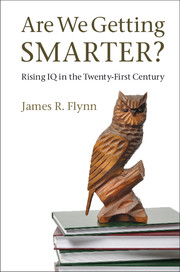Book contents
- Frontmatter
- Contents
- List of Figures
- List of Tables
- List of Boxes
- Acknowledgments
- 1 Opening windows
- 2 IQ and intelligence
- 3 Developing nations
- 4 Death, memory, and politics
- 5 Youth and age
- 6 Race and gender
- 7 The sociological imagination
- 8 Progress and puzzles
- Appendix I IQ trends
- Appendix II Capital cases and comparing the WAIS-III IQs of various nations
- Appendix III Adult/child IQ trends and bright taxes/bonuses
- Appendix IV Gender and Raven’s
- Appendix V Wonderful paper on causes of Raven’s gains
- References
- Subject index
- Name index
Appendix II - Capital cases and comparing the WAIS-III IQs of various nations
Published online by Cambridge University Press: 05 November 2012
- Frontmatter
- Contents
- List of Figures
- List of Tables
- List of Boxes
- Acknowledgments
- 1 Opening windows
- 2 IQ and intelligence
- 3 Developing nations
- 4 Death, memory, and politics
- 5 Youth and age
- 6 Race and gender
- 7 The sociological imagination
- 8 Progress and puzzles
- Appendix I IQ trends
- Appendix II Capital cases and comparing the WAIS-III IQs of various nations
- Appendix III Adult/child IQ trends and bright taxes/bonuses
- Appendix IV Gender and Raven’s
- Appendix V Wonderful paper on causes of Raven’s gains
- References
- Subject index
- Name index
Summary
Box 13 in Chapter 4 gives estimates for American IQ gains for 14 periods all post-1972. It is derived from Table AII1.
This table is useful for analyzing whether the norms of a given test seem eccentric. For example, if a test has substandard norms, it will inflate estimates when paired with a later test and deflate estimates when paired with an earlier test.
Use the Ideal vs. real column to assess the WAIS-III: (1) it is paired with a later test in (1), (3), and (7) and these show deviations of 3.70, 1.07, and 0.07 toward too many points gained; (2) it is paired with an earlier test in (9) and (14) and these show deviations of 0.90 and 2.50 toward too few points gained; (3) the sum of the deviations is 8.24 and divided by 5 equals 1.65, as the number of points by which the WAIS-III inflated IQ scores even at the time it was standardized .
Box 15 in Chapter 4 gives American IQ gains for both the WISC and WAIS from one standardization sample to the next. It is derived from Tables AII2 and AII3.
- Type
- Chapter
- Information
- Are We Getting Smarter?Rising IQ in the Twenty-First Century, pp. 237 - 244Publisher: Cambridge University PressPrint publication year: 2012



